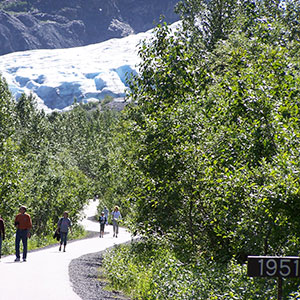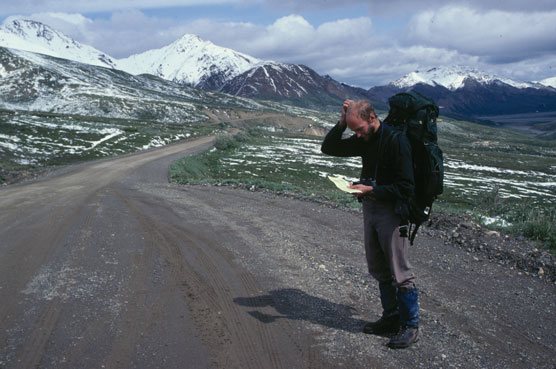
Climate Change

Understanding Climate Change

Once covering a larger area, visitors now walk a path to Exit Glacier showing how it has receded in the last 60 years at Kenai Fjords National Park. In the lower right corner of the image you can see where the glacier terminated in 1951.
NPS photo
There is no doubt that climate change is a complex subject. Scientists who study Earth's climate are looking at more than just weather statistics over time. They consider many factors like atmospheric conditions, sea level, ocean temperature and evaporation rates, amount of water frozen in glaciers and icecaps and rates of melting. They examine how the climate has changed in the past by measuring relative amounts of atmospheric gasses trapped in ice cores for tens of thousands of years. Our planet has experienced many shifts in its climate over time. The Earth where dinosaurs roamed was very different from the place we know today! The biggest difference being that based on what scientists understand about past trends, the changes we are seeing today are far more rapid than anything that has occurred in our planet's history.
Some may see climate change as a dire prediction for a future over which we have no control. But just as human civilization had a role in causing the current climate change, we can use our creativity and ingenuity to find ways to respond to and overcome its challenges.
Climate science helps us understand more clearly the causes of climate change and gives us the tools to work towards a more sustainable future.

A hiker studies a map while standing on the Denali Park Road.
NPS photo
There is no doubt that climate change is a complex subject. Scientists who study Earth's climate are looking at more than just weather statistics over time. They consider many factors like atmospheric conditions, sea level, ocean temperature and evaporation rates, amount of water frozen in glaciers and icecaps and rates of melting. They examine how the climate has changed in the past by measuring relative amounts of atmospheric gasses trapped in ice cores for tens of thousands of years. Our planet has experienced many shifts in its climate over time. The Earth where dinosaurs roamed was very different from the place we know today! The biggest difference being that based on what scientists understand about past trends, the changes we are seeing today are far more rapid than anything that has occurred in our planet's history.
Some may see climate change as a dire prediction for a future over which we have no control. But just as human civilization had a role in causing the current climate change, we can use our creativity and ingenuity to find ways to respond to and overcome its challenges.
Climate science helps us understand more clearly the causes of climate change and gives us the tools to work towards a more sustainable future.
Special Park Uses
Badlands National Park's rugged beauty and spectacular scenery lead many to consider its use as a backdrop for filming, organized activities, or wedding ceremonies. A special park use is a short-term activity, like those mentioned, that occurs in a National Park Service area and:
Special park uses, if approved, require the issuance of Special Use Permits and payment of permit fees before the activity can be held in the park. Special Use Permits must be acquired for commercial and independent filming, weddings, and commercial photography.
Application for Special Use Permit (online pay.gov form)
Application for Special Use Permit (pdf form to print & mail)
Commercial Use
The completed application must be submitted with $100.00. The $100.00 is a non-refundable application and administrative charge. This fee should be in the form of cash (though not by mail), certified check, or credit card information. Other administrative fees may also apply.
|
Commercial Filming/Videos |
Still Photography |
||
|
1 - 2 people (camera & tripod only) |
$0/day |
1 - 10 people |
$50/day |
|
1 - 10 people |
$150/day |
11 - 30 people |
$150/day |
|
11 - 30 people |
$250/day |
Over 30 people |
$250/day |
|
31 - 49 people |
$500/day |
|
|
|
Over 50 people |
$750/day |
|
|
To apply for a Special Use Permit, print and complete the appropriate form above, attach any required fees, and mail it to the address specified on the form. For further information about obtaining a Special Use Permit or determining if your activity needs a permit, please contact the Chief Ranger.